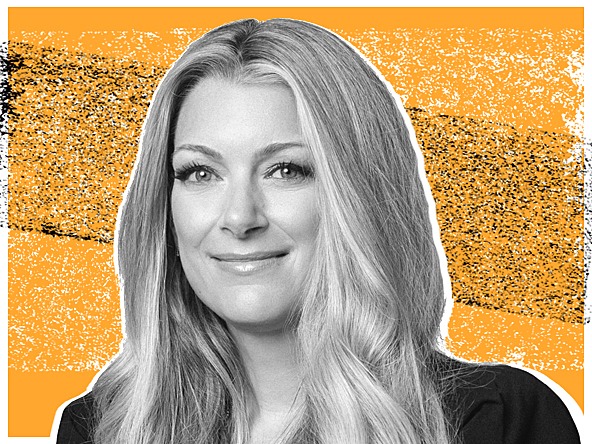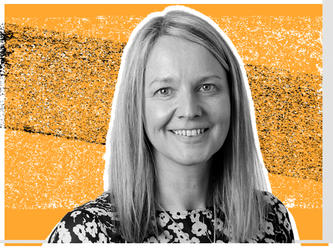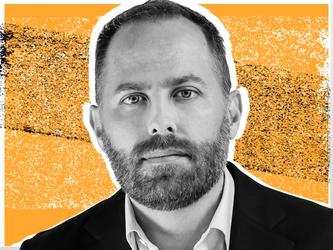How I work: Monica Dreger, global head of research, Airbnb

What does an average day look like for you?
First of all, there is no average. More often than not, I wake up around 5.30 or 6am – our whole family is early risers so the household is up and about. I exercise for 20 minutes, and I’m trying to do this meditation journal to reflect in the mornings, so, since it’s been a little warmer in New York, I’ll go outside, have breakfast and journal a little. I have two large dogs, so I’ll have them out, take the kids to school and come to my home office around 8 o'clock.
I tend to start by scanning emails to see if there’s any crisis happening. If not, I’ll go to my personal emails and then at 8.30am I start work. I try to compartmentalise a lot: working from home has a beauty but it also has the ability to mesh personal life and work life so I try to set aside any personal emails and then really focus on work.
My team is all over the world – including Asia-Pacific and Latin America, so we might start very early, but as my office is in San Francisco at the Airbnb headquarters, at other times the day can end very late. So that’s why the average day is very atypical depending on what meetings there are.
What is your blend of office and home-based work?
I go to the San Francisco office one week per month, and then usually there’s another trip somewhere else every six weeks. My week in San Francisco is very different from when I’m working from home.
Do you have a preference?
My preference is the arrangement I have. There’s a beauty to having this debate in our society because it shows there’s no one right answer. Even for me, there’s no one right answer. I see the pros and cons of both.
I love being able to work from home – I was able to live in Mexico for almost two years because of that. I’m able to take my kids to school, and when they come home, have a five-minute interaction with them, hang out with my dogs, go outside when it’s nice and try to soak in some vitamin D. Those are things I wasn’t able to do before, but I recognise the connection part: quick conversations in the office. We don't have that, working from home.
What is your leadership style?
I am very transparent and I'm one person. Who I am is who I am and I bring my whole self and that’s part of my leadership style. I’m sarcastic, I love humour, I love understanding people, that’s why I got into insights from the very beginning – I’m a curious person. Part of my leadership style is getting to know people as human beings and understanding them.
Bringing your full self doesn’t mean that you have to reveal anything. You can have as many boundaries as you want, but it does mean you can feel comfortable bringing that whole self to the table.
I don't micro-manage. I think even if I wanted to, I couldn't, because that’s not who I am. I put a great deal of emphasis on hiring, so I surround myself with key functional leaders that are great in what they do. If it takes a long time to hire, I will gladly delay the process to get the people that I feel are the best in what they do – from both a functional point and a collaborative point: exceptional technical leaders who also have a collaborative spirit and this attitude of us together. We bring issues to the forefront and we bring solutions together, too. That’s very important to me. Having an honest transparent relationship is key to who I am and how I think it works best. I think that we’re a chain – we’re as weak as our weakest link and as strong as our strongest link.
I was able to build the consumer insight team from a person of one to what it is now [a team of around 70 ]. The UX research team was already there, so bringing those two teams together has been magical. We have a neuroscientist on our team, a foresights person, an anthropologist, statisticians. We have all these very specific technical skills. Working alone is not where the magic is – the magic is bringing people together. You have to hire people who want to work together, and they’re not just there to make a name for themselves – everyone wants that, but it shouldn’t be the only motivator. Hiring people who want to see themselves as part of this group success is important.
What advice would you share for leaders leading remote teams across borders?
It comes with its own complexities. Before the pandemic, in one of my former lives, I led global teams too, and we didn’t have the technology or even the expectation to include the regional teams together. So the way I look at it is this is actually a really good problem to have. We’re incorporating a lot more of these global teams: we’re becoming more collaborative and visibility is higher.
Having said that, there are technical issues and non-technical issues. On the time zone issue, we rotate a lot of the global team meetings – it might be 7.30am for some people. We do tell people that we’re going to record these so if they cannot make it we understand. We rotate it so it’s not always 7.30am; we’ll do the reverse for another meeting.
On the non-technical side, it is about creating moments of connection. I have an amazing admin, Octavia. Slack seems to work well for the team and she works really hard to create these moments of connection. On Mondays, for example, she’ll ask the team to share their weekend moments and people put their photos in of what they did. It’s about humanising each other and breaking down barriers, making us more approachable and understanding. We also work a lot with Google Docs to allow us to work together asynchronously.
We also try to have a lot of get-togethers, including a big team meeting in San Francisco and smaller sub-team meetings. I try to make sure those off-sites have moments for talking, sharing and being collaborative on a project.
How do you approach work-life balance? Does it come naturally?
With age, yes! I've embraced it more, but I've had to work hard at it. I had to process, reflect and adjust a lot, again with the help of my admin. We would come up with ideas like blocking off Monday with no meetings, and then we found that was unrealistic. For me, it was a process.
There’s one thing about work-life balance that I've found is really important. As a society, we went through really difficult pandemic years when we were all in crisis mode and fight mode. Now, we are still not relaxing, we’re not taking the foot off the pedal. I feel like as a society we said: ‘OK, that worked, let’s keep going at that pace’. For leaders, it’s really important to keep reminding people about self-care, to carve out time for yourself and what self care looks like so it doesn't get to the point of burnout. Proactive self care is really important, so that would be my call to leaders: look out for your people. We want people to be productive, obviously, but we want them to be motivated for the long run, and be innovative and creative, and you can’t do that if you’re already on the path to burnout.
It’s important to model that behaviour – I won’t be checking emails regularly on a forthcoming holiday and I let my team know that, and we have put in a plan for how it will work. Leaders are apologetic about taking the time but I’m not going to be apologetic about it because it’ll be better for everyone when I come back refreshed.
What helps you to be productive?
It’s very personal, but for me, organisation was the key. I need very strict organisation, so my calendar is very organised. For some people, that might be anxiety-inducing. I will put everything in that calendar – I will put in the 20 minutes I’m going outside to have breakfast. It’s colour-coded so I know from glancing at it in the morning what the day will look like in terms of priorities. Work emails are prioritised and colour-coded.
List-making is also very important to me. It’s very important for me to cross things off on the list, that’s the motivator. I’ll put things in, knowing I can cross them off! At the end of the day, I take 20 minutes before I go into my personal life, to reflect on the day, go over the list and create the list for the next day. That has been very important for me, or else I'll end up doing other things.
This is not going to be conventional, but what has helped my work-life balance is having a busy personal life with a lot of commitments and a lot of interests and hobbies. We tend to de-prioritise our personal life – I know I did for many years and still kind of do, it’s a work in progress. I like pottery, so at one point I was doing it at home, but I realised I wasn’t making time for it. So I signed up for a class, which means I’m accountable to that. I have to go, so it prioritises that hobby instead of just leaving it up to chance.
What are your other hobbies?
I’m renovating our house so that is a very big hobby right now. Interior design is something I’ve always been interested in and loved doing. This is a bigger project than I had originally planned. Pottery is another: we all need a creative outlet. Working with your hands is very cathartic.
I have three kids that keep me busy and their interests have become a lot of my interests too, so we do things together. Sport is a big thing for my boys and my daughter loves animals, so we have pets and we’re fostering and rescuing animals all the time; that’s another big part of my life.
It sounds busy.
Being in this phase of my life where reflection, thinking and processing is very big, I realise that I actually thrive at that level. Too relaxed, I tend to think: ‘Why is it so calm?’ Keeping busy but in an organised busy way is how I work best.
What else motivates you outside of the day job?
There’s two things that motivate me – one is the younger generation, especially young female leaders. I love the empowerment and the powerful stance of the younger generation, so I really try to mentor and stay close with this generation of women.
The other thing is my advocacy work. Hearing loss and inclusivity is a big part of my life. I have hearing loss; I rely on hearing aids and captions and subtitles. There are a lot of things that have improved my life personally and professionally, so my goal is to make sure other people know about them to break down barriers of hearing loss and invisible disability that people might not be aware of and might not know how to interact with or manage.
What advice would you give to others who are looking to balance competing priorities at work and manage their workload effectively?
Everyone is in a moment now where we’re constantly fire-hosing and at the same time trying to work on longer foundational work projects that we know are going to make a difference but at the moment might not seem prioritised.
I tend to do the 80/20 rule – taking out fires and working on critical projects but always keeping an eye on those projects that need to move along because once they stop they tend to get forgotten. I try to protect those, even if it means slowing down but it means keeping them in the pipeline. Organisational structure is very important: how you organise your team and what people work on is probably the key to that.
Keeping honest and clear communication with stakeholders is the other thing: being realistic. Right now, our industry is about speed. The commodity is how fast you get things done. We’re always very clear to our stakeholders that we will go at the fastest pace we can without deteriorating quality or without taking away what needs to happen for the project to be successful. Making them understand that there’s some things you can rush along and some things that you can't.
The other thing we’ve been doing lately is not waiting for the final reveal – creating these little moments of surprises along the way. Gone are the days of large projects that would take months and we would go away and do our magic and come back with a presentation and a deck and the big reveal. Those don't happen anymore in my world. We rely a lot on bringing our stakeholders along in the way of videos, for example. We’ll create a little video reel to keep the momentum going and to give some of the insights that we know are going to be important and that show up early from analysis.
This interview has been lightly edited for clarity.
The How I work series explores how research leaders manage work and life, lead teams, and find inspiration.

We hope you enjoyed this article.
Research Live is published by MRS.
The Market Research Society (MRS) exists to promote and protect the research sector, showcasing how research delivers impact for businesses and government.
Members of MRS enjoy many benefits including tailoured policy guidance, discounts on training and conferences, and access to member-only content.
For example, there's an archive of winning case studies from over a decade of MRS Awards.
Find out more about the benefits of joining MRS here.














0 Comments